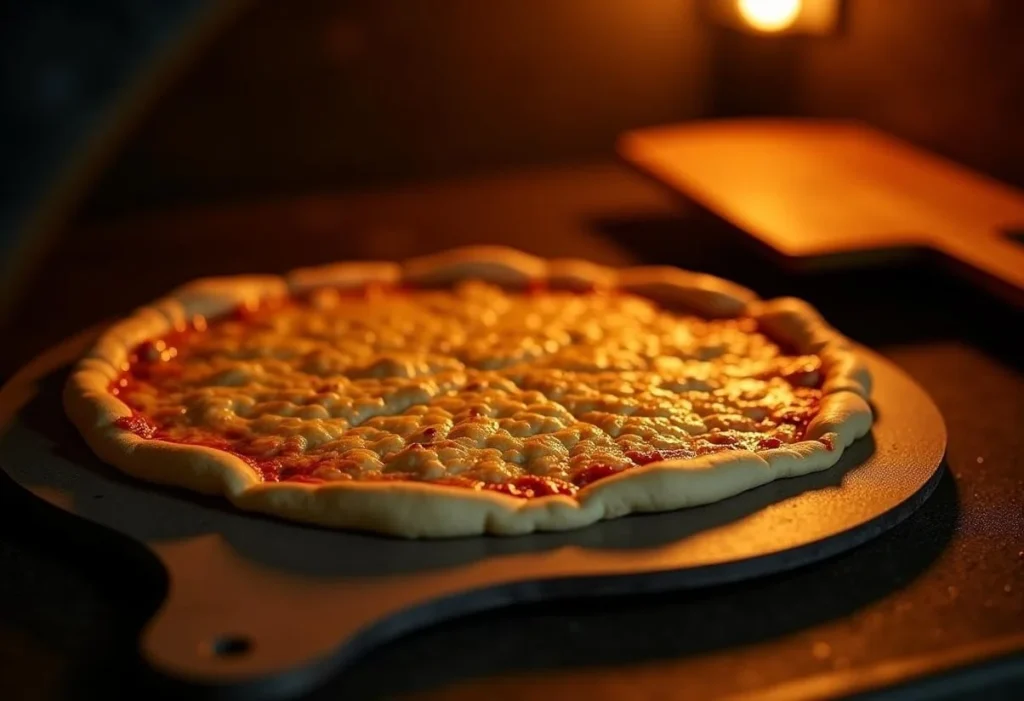Introduction
Are you wondering, “How do you make cauliflower crust crispy?” Cauliflower pizza crust has gained immense popularity as a healthy, gluten-free, and low-carb alternative to traditional pizza dough. Perfect for those following keto, vegan, or gluten-free diets, this versatile option offers the satisfaction of pizza with fewer carbs and more vegetables. However, while its health benefits are well-known, the main challenge lies in achieving the ideal texture—crispy on the outside yet sturdy enough to hold your favorite toppings.

Crafting the perfect cauliflower pizza crust involves more than just mixing ingredients. It requires attention to detail, such as preparing the cauliflower correctly, managing moisture levels, and using the right baking techniques. In this guide, we’ll explore cauliflower pizza crust recipes that are easy to follow, share tips to prevent sogginess, and answer common questions like whether cauliflower crust is supposed to be crunchy. By the end, you’ll be ready to create the best cauliflower pizza that’s not only healthy but also irresistibly crispy.
Why Is Cauliflower Pizza Crust Popular?
Cauliflower pizza crust has surged in popularity, thanks to growing health and dietary trends. Unlike traditional pizza dough made with refined flour, cauliflower crust offers a nutrient-packed alternative that’s lower in calories and carbs. This makes it a perfect choice for those looking to reduce their carb intake while still enjoying the flavors of pizza. Rich in fiber, vitamins, and antioxidants, it aligns with health-conscious eating habits.
Its versatility is another reason for its widespread appeal. Cauliflower pizza crust can be adapted to fit a variety of diets, including vegan, keto, and gluten-free lifestyles. With options like the vegan cauliflower pizza crust recipe, it’s easy to customize the crust for different dietary preferences without sacrificing flavor or texture. For many, the best cauliflower pizza represents the ideal blend of health, taste, and creativity, making it a favorite in kitchens everywhere.
The Basics of Making Cauliflower Pizza Crust
3.1. Ingredients Overview
Creating a cauliflower pizza crust starts with a simple set of ingredients. For a classic 3-ingredient cauliflower pizza crust, you’ll need cauliflower, cheese, and an egg. These staples provide the structure and flavor essential for a delicious base. Seasoning such as garlic powder, dried herbs, or salt is often added to enhance the taste.

For those following specific diets, variations can easily be made. If you’re aiming for a vegan option, you can substitute eggs with a flaxseed mixture (1 tablespoon of flaxseed meal mixed with 3 tablespoons of water) or chia seeds. Plant-based cheese can replace dairy cheese to maintain flavor while keeping it vegan-friendly. These swaps make it simple to customize your crust while adhering to your dietary needs.
3.2. Preparation Steps
The process of making a crispy cauliflower crust requires attention to detail, starting with prepping the cauliflower. Begin by steaming or microwaving fresh cauliflower florets until tender. Then, use a food processor to pulse the cauliflower into a rice-like consistency. Transfer it to a clean towel and squeeze out as much moisture as possible—this step is critical to avoid a soggy crust.
Next, combine the cauliflower with cheese, an egg, and seasoning in a mixing bowl. Mix until it forms a dough-like consistency. Spread the mixture onto parchment paper, shaping it into a thin, even circle or rectangle. Thin layers are key to ensuring crispiness.
Finally, bake the crust at a high temperature (around 425°F/220°C) on a baking sheet or pizza stone. Preheating the oven and ensuring proper heat circulation is essential. For extra crispiness, some prefer to flip the crust midway through baking. These steps are the foundation for answering the question, “How do you make cauliflower crust crispy in oven?”
For additional tips on how to prepare cauliflower for cooking, this guide offers excellent insights.
Mastering the Crispy Texture
4.1. Why Is My Cauliflower Pizza Crust Soggy?
A soggy cauliflower crust is a common frustration, and it often boils down to a few key mistakes. One of the primary culprits is insufficient moisture removal from the cauliflower. Even when processed and cooked, cauliflower retains a significant amount of water. If not thoroughly squeezed out, this moisture seeps into the crust during baking, leaving it limp and soggy.
Another issue is baking at too low a temperature or skipping the step of preheating the oven. Baking the crust at high heat is essential to evaporate moisture quickly and create a firm, crispy texture. Low heat not only delays this process but can also make the crust more prone to sticking.
To understand the importance of high-temperature baking, this article explains the science behind it.
Solutions:
- Thorough Moisture Removal: Use a clean kitchen towel or cheesecloth to wring out as much water as possible from the cauliflower. The drier the cauliflower, the better the crust.
- Preheat the Oven: Always preheat your oven to at least 425°F (220°C). A hot oven ensures immediate cooking and crisping of the crust surface.
- Use Proper Tools: Baking on parchment paper, a pizza stone, or a preheated baking sheet helps distribute heat evenly, reducing sogginess and improving crispness.
If you’ve been asking, “How do I make my crust more crispy?” these adjustments are the foundation for success.
4.2. Tips for a Crispy Crust

Achieving the perfect crispy crust requires more than just the basics. Here are some advanced techniques:
- Baking Surface Matters:
- Baking directly on a pizza stone ensures better heat distribution, creating a uniformly crispy base.
- Alternatively, bake the crust on parchment paper for easy transfer and to prevent sticking.
- Optimal Oven Temperature:
- Use a temperature of 425°F to 450°F (220°C to 230°C) for optimal results. Higher heat encourages water evaporation and browning. Convection oven settings, if available, enhance heat circulation for even crisping.
- Flip the Crust:
- To ensure both sides are crisp, flip the crust midway through baking. This technique prevents any residual moisture on the bottom from softening the texture.
- Enhance Binding and Texture:
- For added firmness, mix a tablespoon of cornstarch or almond flour into the crust batter. These ingredients absorb excess moisture and create a slightly firmer bite.
These strategies are particularly helpful when working with a frozen cauliflower pizza crust, which can sometimes require extra care to achieve the desired texture. With these methods, you’ll consistently produce the best cauliflower pizza every time.
4.3. Is Cauliflower Crust Supposed to Be Crunchy?
If you’re wondering whether a cauliflower crust should mimic the crunch of a traditional pizza crust, the answer is: not exactly. While a well-made cauliflower crust is crispy on the outside and firm enough to hold toppings, it won’t have the same hard crunch as traditional dough. Instead, it offers a satisfying firmness and a lightly crisp texture.
The balance lies in ensuring the crust is sturdy without becoming too dry or brittle. A too-thick crust may stay soft in the center, while one that’s too thin might crack or break when handled. Spreading the crust evenly—about ¼ inch thick—is key to achieving the perfect balance.
Additionally, the toppings you choose can influence the texture. Avoid overly heavy or wet toppings, as they can weigh down the crust and reduce crispiness. Instead, opt for lighter, drier ingredients like roasted vegetables or shredded cheese.
A well-executed cauliflower pizza crust recipe delivers a firm, slightly crisp base that complements any topping without overpowering it. It’s not about mimicking traditional crusts but embracing the unique qualities of cauliflower as a versatile and healthy alternative.
Variations for Different Diets and Preferences
5.1. Quick and Simple Recipes
For busy cooks, creating a quick cauliflower pizza crust recipe is all about simplicity. A 3-ingredient cauliflower pizza crust is the perfect solution. Combine riced cauliflower, shredded cheese, and an egg for a base that’s both easy to prepare and delicious. Simply mix the ingredients, shape the crust, and bake as usual.
If you’re short on time, consider a microwave-friendly method. Microwave fresh or frozen cauliflower until tender, then mix it with cheese and an egg. Shape the mixture into a crust and bake it in the oven or cook it on a stovetop skillet for a quick and crispy alternative. These approaches reduce preparation time while still delivering a satisfying crust.
5.2. Vegan and Gluten-Free Options
For those following a plant-based diet, a vegan cauliflower pizza crust recipe offers a delicious alternative to the traditional version. Replace the egg with chia or flaxseed gel (1 tablespoon of chia or flaxseed meal mixed with 3 tablespoons of water) as a binding agent. Use dairy-free cheese to complete the recipe.

To keep the crust gluten-free, opt for gluten-free bread crumbs or almond flour as a substitute for wheat-based fillers. These ingredients not only ensure dietary compliance but also enhance the crust’s texture and flavor. Vegan and gluten-free crusts can be just as crispy and versatile as their traditional counterparts, making them an excellent choice for anyone with dietary restrictions.
5.3. Store-Bought and Frozen Options
When time is tight, a frozen cauliflower pizza crust can be a lifesaver. These pre-made crusts are widely available and cater to various dietary preferences. However, they often lack the crispiness of homemade versions.
To enhance a store-bought crust’s texture:
- Bake Directly on a Pizza Stone or Rack: Skip the baking sheet to promote even heat distribution and avoid sogginess.
- Preheat the Oven: Ensure your oven is fully preheated to a high temperature (425°F/220°C) before baking.
- Customize Seasoning: Add extra garlic powder, herbs, or a sprinkle of cheese before baking to elevate the flavor.

Frozen options offer convenience without sacrificing quality, especially when paired with light toppings to maintain the crust’s structure. With these tips, even pre-made crusts can rival the crispiness of homemade creations.
Common Mistakes and How to Avoid Them
Making a crispy cauliflower pizza crust can be tricky, especially when common mistakes lead to soggy or underwhelming results. Here are the most frequent pitfalls and tips to avoid them:
1. Not Squeezing Enough Moisture
The number one mistake is failing to remove enough moisture from the cooked cauliflower. Excess water prevents the crust from crisping and causes it to fall apart. Always use a clean kitchen towel or cheesecloth to thoroughly wring out the cooked cauliflower before mixing it with other ingredients. The drier the cauliflower, the better the texture.
2. Uneven Spreading
Another error is spreading the crust mixture too thick or unevenly. Thick areas may stay soft in the middle, while thinner areas become brittle. To ensure consistent crispiness, spread the mixture evenly into a thin layer, about ¼ inch thick. Using a spatula or your hands can help achieve a uniform surface.
3. Incorrect Baking Times and Temperatures
Baking at low temperatures or not preheating the oven can result in a limp crust. For the best results, bake the crust at 425°F (220°C) on a preheated pizza stone or baking sheet. If you’re wondering, “How do you make cauliflower crust crispy in oven?” the answer lies in baking at high heat and flipping the crust halfway through cooking to crisp both sides.
4. Fixing a Soggy Crust
If your crust turns out soggy despite your efforts, place it back in the oven at a higher temperature for 5–10 minutes. Avoid adding toppings until the crust is firm and dry to the touch.
By addressing these common mistakes, you can consistently create a crispy and delicious cauliflower pizza crust that stands up to your favorite toppings.
FAQ Section
1. Why Is My Cauliflower Pizza Crust Soggy?
Struggling with a soggy cauliflower pizza crust? Excess moisture is often the culprit, but with the right preparation and baking techniques, you can achieve a firm and crispy crust. From draining methods to baking tips, there are several ways to improve your results. For a complete guide on fixing soggy cauliflower crusts, read the full article here: Why Is My Cauliflower Pizza Crust Soggy?.
2. How Do I Make My Crust More Crispy?
Want to achieve a crispier cauliflower pizza crust? There are several techniques that can help enhance its texture and prevent sogginess. From adjusting your baking method to using the right ingredients, small changes can make a big difference. To discover the best tips and tricks for making your crust perfectly crispy, check out our full guide here: How Do I Make My Crust More Crispy?.
3. Is Cauliflower Crust Supposed to Be Crunchy?
Cauliflower crusts are designed to be crispy yet flexible. Unlike traditional pizza dough, they won’t have the same hard crunch but should be firm enough to hold toppings without breaking. The key is finding the right balance between crispiness and pliability. Spreading the mixture evenly, baking at high heat, and avoiding overly wet toppings will help you achieve the perfect texture. A good cauliflower crust is crisp on the outside, tender on the inside, and packed with flavor.
Conclusion
So, how do you make cauliflower crust crispy? It’s all about attention to detail and the right techniques. Properly preparing the cauliflower by removing excess moisture, spreading the mixture evenly, and baking at high heat are the keys to success. Whether you’re using a homemade recipe or enhancing a store-bought version, the steps outlined here will help you achieve the perfect crispy texture.
Cauliflower pizza crust is not only a healthy alternative but also incredibly versatile. From a classic cauliflower pizza crust recipe to vegan and gluten-free variations, there’s an option for everyone. Plus, it’s customizable with your favorite toppings, making it ideal for any dietary preference.
Experiment with the tips shared in this guide to create the best cauliflower pizza that’s both delicious and satisfying. With a little practice, you’ll master the art of a crispy crust that rivals traditional dough.

